The Fukuroshinai
History & Manufacture of the Bokken & Shinai ancestor
What’s a Fukuroshinai?
A fukuroshinai is a training sword consisting of a bamboo stick split finely at the tip, and inserted into a leather sheath. The sheath is made out of deer leather and resembles a special bag that was sometimes used to protect a katana’s saya. It is said that the fukuroshinai was devised by Kamiizumi Ise no Kami Nobutsuna, founder of the Shinkage Ryu school of swordsmanship.
Before the creation of fukuroshinai, people trained with wooden swords or dull blades, often leading to potentially severe injuries.
It is surprising to see that, even if 450 years have passed since its inception, the fukuroshinai is still used, in its original form, in most Shinkage Ryu-related dojos. In fact, modern science and newly engineered materials still fail to surpass bamboo, a fast growing and easy to process substance that features excellent elasticity and shock absorption properties.
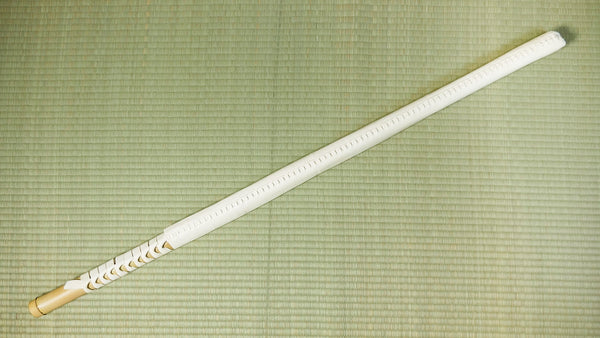
Example of a Fukuroshinai
Looking for the Right Bamboo.
Needless to say, people who live in large urban areas do not have easy access to bamboo groves, and finding the base for a fukuroshinai will prove difficult. One may find bamboo sticks at home centres and various gardening stores, but they generally come from China where they were treated with caustic soda (oil removing process): that damages the fibres and the bamboo tends to break after only a few practice sessions.
A few years ago, we got in touch with many Bamboo suppliers, in search for a materials for high quality Fukuroshinai. We wanted to find a way to provide a stable number of fukuroshinai for the international Budo community. As for nearly all the craftsmen we are working with, we discovered that those bamboo suppliers were disappearing very fast.
This is where we found “Bamboo Japan”, led by Mr Kenji Aki. They are located in Gifu prefecture and specialise in everything related to bamboo, from making tools or parts to management and logging of neglected bamboo forests.
Mr Aki told us that he was contacted by members of some very famous Yagyu Shinkage Ryu Dojo and that he was already manufacturing very high quality Yagyu Fukuroshinai. He offered to taylor the Fukuroshinai to our needs, but as we usually do at Seido, we adapted to the craftsmen.
How to wrap your Fukuroshinai with Master Aki Kenji
What’s the Best Bamboo for Fukuroshinai?
Mr Aki explained that he spent more than five years researching and experimenting in order to find the most suitable bamboo and the best processing methods for fukuroshinai. Bamboo is notorious for its strong fibres, but did you know that there are actually various types of bamboo?
In Japan, the most used are “Madake” (phyllostachys bambusoides) and “Hachiku” (phyllostachys nigra).
— Madake is mainly used for kendo 4-slat shinai and kyudo bows. Madake is hard to tear but breaks easily.
— Hachiku is used for tea utensils such as chasen (tea whisk). It is hard to break but easy to tear.
The 4-slat kendo shinai is made from thick madake. Kendo is a full-contact martial art where bamboo swords hit very resistant protective gears: they must be made out of thicker, harder and heavier bamboo in order to increase the shinai durability. However, such bamboo sword can inflict significant damage to the human body, which, in some cases, can be lethal.
Fukuroshinai on the other hand feature at their core a single slim trunk of bamboo, with its tip split into 8 or 16 thin slats. This makes a softer and lighter weapon, which, although less durable than a kendo shinai, reduces dramatically damages inflicted to the opponent’s body.
The most common accident with fukuroshinai happens when one blocks a strike to the head and the opponent’s bamboo sword breaks, bends over and reaches the forehead or the eyes. To reduce that risk, Japan made high end fukuroshinai are now exclusively made of hachiku bamboo, relying on its resilient properties.

Tip of the Fukuroshinai, without the Sheath.
Regarding the Fukuroshinai Sheath.
As the need for bamboo has increased among the martial arts community, so has the demand for better quality sheaths. Bamboo suppliers aren’t tanners and do not have experience working with leather. Consequently, when asked to provide both bamboo and sheath, they used to rely on other martial arts stores to supply leather parts.
Unfortunately, the sheath quality and its supply chains are not stable and don’t allow for sustainable production. Mr Aki decided to take the leap and manufacture his own brand of fully mounted fukuroshinai. It took a long time but he finally found in Hyogo Prefecture a traditional leather artisan who now provides all the leather required for his fukuroshinai production.

Sheath of the Fukuroshinai
Hyogo Prefecture has a few rivers where water quality is suitable for tanning leather, and the area had been for a long time the center of a flourishing leather industry. Unfortunately this is also a declining sector, and like bamboo suppliers, tanners and workshops inexorably go out of business.
Although the Budo equipment industry’s impact on the overall demand is very small, we also hope to help revive the industry by manufacturing fukuroshinai sheaths there.
Mr Aki had to go through a long trial-and-error process going back and forth with both local artisans and Yagyu Shinkage Ryu Dojos in order to find the best tanning method, the best leather, the perfect piercing blades, sewing pitches, and the most durable lacquering. It probably took several years to reach the current high quality Fukuroshinai that is produced at his workshop.
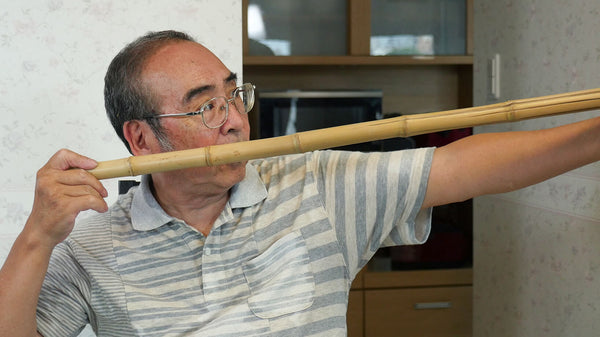
Master Aki Kenji, in our office
Until now, martial artists generally had no choice but to make their fukuroshinai by themselves or to buy lower grade made in China products.
Needless to say, the skills to properly shape and split bamboo are not easily acquired: more often than not, the improperly carved bamboo slats would slowly tear the tip of the sheath until they completely break it, putting at harm the practitioners.
Seido’s fukuroshinai’s tip is subjected to a two-step safety process and check to prevent accidents.
Finally, the craftsmen also take extra care when lacquering the sheath, providing a coating that will not peel off from the leather after the drying process and that will resist the strong impacts from clashing swords.

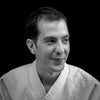
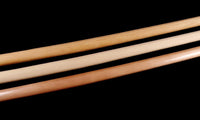
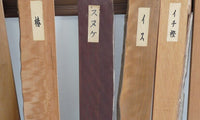
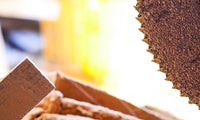
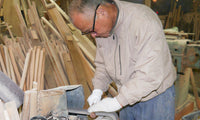
2 コメント - The Fukuroshinai - History & Manufacture of the Bokken & Shinai ancestor
Hello Jordi, is a tsuba available for the furukoshinai?
Hi,
Good Article, do you know which kind of lacquer it is used for the Fukuroshinai Sheath?